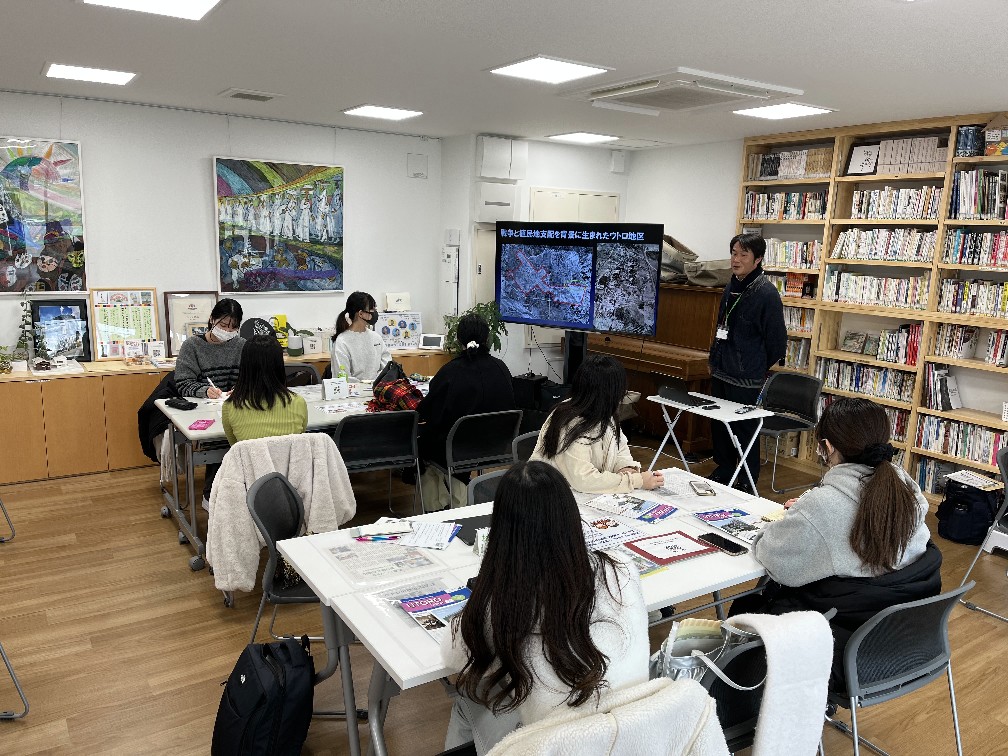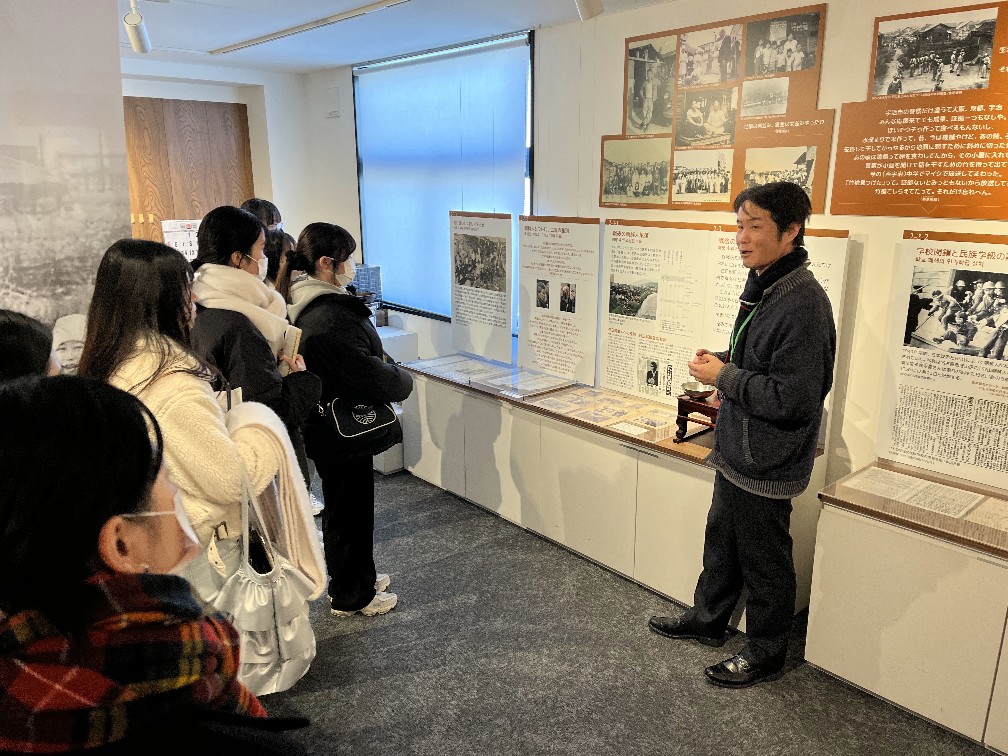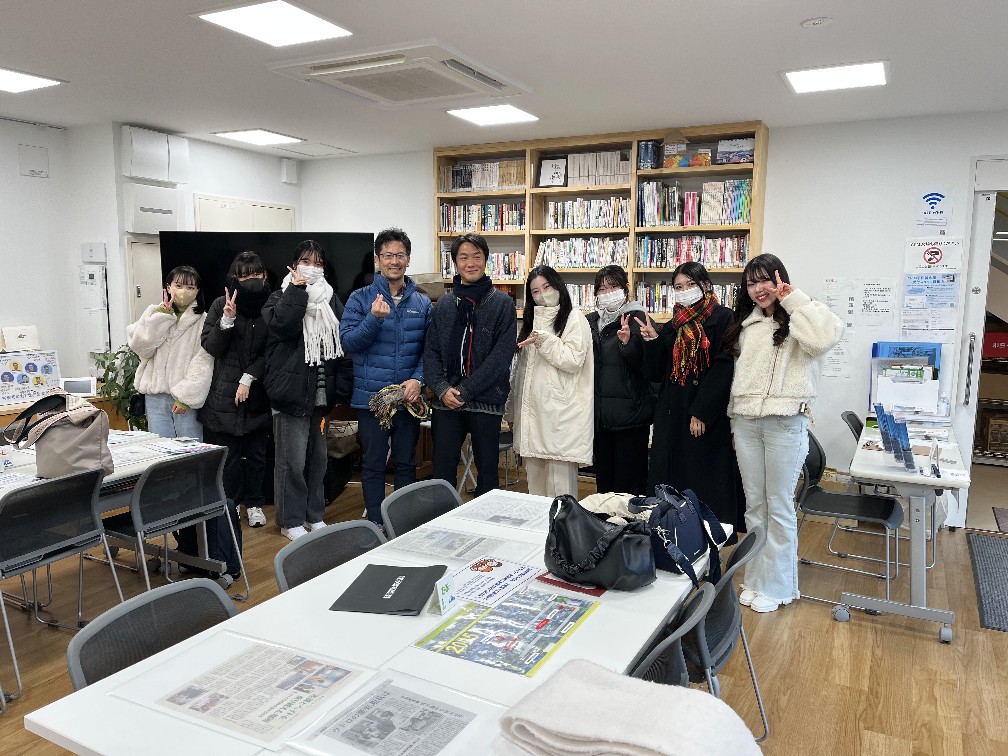私たち摂南大学外国語学部/国際学部の森ゼミナールは、2024年1月26日(金)に京都府宇治市伊勢田町ウトロにある「ウトロ平和祈念館」を訪れました。ウトロは、「1940年から日本政府が推進した『京都飛行場建設』に集められた在日朝鮮人労働者たちの飯場跡に形成された集落」(ウトロ平和祈念館ホームページ「ウトロ地区概要」より)で、ウトロの人々は劣悪な環境と過酷な差別の中で懸命に生き抜き、お互いに助け合いながら生活してきました。ウトロ平和祈念館ホームページには次のようなメッセージが掲載されています。
ウトロは戦争の時代に形づくられた、日本社会から「置き去りにされた」朝鮮人のまちでした。しかし困難に直面しながら声を上げた人々と、ウトロに寄り添ってきた日本市民、在日コリアン、そして韓国市民が協力してウトロの歴史と居住権を守った歴史は日本と朝鮮半島が互いに理解を深めあい、力を合わせ、地域社会で「小さな統一」をつくることによって新しい社会と未来を築いていけることを示してくれています。(ウトロ祈念館ホームページ「ウトロ地区概要」から引用)
ウトロ平和祈念館は、ウトロの歴史を後世に伝えることだけでなく、「ウトロで終わらないウトロの話」と掲げているように、ウトロを通して平和・人権に関心を広げていくことを目指しています。
ウトロ平和祈念館に到着した後、まず副館長の金秀煥(キムスファン)さんから講話を聴きました。金副館長は、ウトロ地区の形成から現在に至るまでの歴史的変遷、ウトロ地区で生きる人々の境遇や心境、差別とヘイトクライム(特に、2019年に起こった「ウトロ地区放火事件」)、そしてウトロ平和祈念館が伝えたいメッセージについて熱心に語ってくださいました。金副館長のお話を通して、上下水道が近年まで整備されなかったことなど、私たちが想像できないような生活環境の中で暮らしてきたことなど、ひどい差別があったことを学びました。しかし、住民は希望を失わず、人間として当然のことを要求して諦めずに声を上げ続けたことや周辺住民の支援活動があったこと、韓国市民の声が韓国政府を動かしてウトロ支援に結びついたことなどについて学習しました。
講話の後に平和祈念館の展示コーナーを案内していただきました。年表や当時の写真、住民の私物や韓国の楽器など様々なものが展示されていました。金副館長の説明と共にウトロ地区の形成から始まる展示パネルを見ることで、ウトロ地区の歩んだ歴史や、ウトロ地区で生きた人々の生活にリアルに感じることができました。
平和祈念館の屋上にも案内していただきました。屋上からはウトロ地区が一望でき、実際に京都飛行場があった場所や住民の集落があった場所を自分の目で確かめることで、ウトロ地区を体感することができました。
祈念館の展示を見た後、質疑応答の時間を持ちました。金副館長は私たちの質問に丁寧に答えてくださいました。差別の問題はもちろん、ウトロ地区を去った人々のこと、韓国ポップカルチャーブームがウトロ地区や住民、韓国にルーツを持つ人たちに対してどのような影響を与えているのかなどについて金副館長の見解をうかがいました。
実際にウトロ地区に足を運んでみると、それまで抱いていたイメージが変わり、差別やヘイトクライム、歴史について深く考えさせられました。金秀煥副館長は、お話の中で何度も「かわいそうな他者ではなく、自分たちの問題としてとらえてほしい」とおっしゃっていました。私たちが知らない歴史、過酷な状況がウトロ地区のみならず、世界中の様々な場所であります。「知らない」「関係ない」と他人事にするのではなく、「私たちの社会で起きていること」と、まずは関心を持つことが大切だと感じました。私たちができることは、「学び、考え、伝える」ことであり、ゼミ活動や今回の学習を通して、私たちが学ぶ意味を再確認することができました。
お忙しい中、お時間を取っていただいた金秀煥副館長をはじめ、ウトロ平和祈念館の方々に心からお礼を申し上げます。
♢ウトロ平和祈念館HPは、以下のURLよりご覧ください。https://www.utoro.jp/
(外国語学部/国際学部3年生 石田みほり)
<한국어>
우리 세쓰난대학교 외국어학부/국제학부 모리세미나는 2024년 1월 26일(금요일)에 교토부 우지시 이세다초의 우토로(京都府宇治市伊勢田町ウトロ)에 있는 우토로 평화기념관을 방문했습니다. 우토로 마을은 “1940년부터 일본 정부가 추진한 ‘교토 비행장 건설’에 동원된 조선인 노동자들의 함바 터에 형성된 마을”입니다(우토로 평화기념관 홈페이지 ‘우토로 마을 역사 이야기’에서 인용). 우토로 마을의 사람들은 열악한 환경과 과혹한 차별 속에서 열심히 살아와 계셨고 서로 도우면서 생활하셨습니다. 우토로 평화기념관 홈페이지에는 다음과 같은 메시지가 게재되고 있습니다.
“우토로는 전시에 형성된, 일본 사회로부터 「방치된」 조선인 마을이었습니다. 하지만 어려움에 직면하면서도 목소리를 높인 사람들과 우토로 곁을 지켜 온 일본 시민들, 재일코리안, 그리고 한국 시민들이 협력해서 우토로의 역사와 거주권을 지켜낸 역사는, 일본과 한반도가 서로 이해를 증진하고 힘을 합쳐, 지역 사회에서 「작은 통일」을 만듦으로써 새로운 사회와 미래를 만들어 나갈 수 있음을 보여주고 있습니다.” (우토로 평화기념관 홈페이지 ‘우토로 마을 역사 이야기’ 에서 인용)
우토로 평화기념관은 우토로 마을의 역사를 후세에 전하는 것 뿐만 아니라, ‘우토로에서 끝나지 않는 우토로의 이야기’라고 홈페이지 전면에 쓰여 있는 듯이, 우토로를 통해서 평화 및 인권을 확대시키는 것을 지향하고 있습니다.
우리 모리세미나 일행이 우토로 평화기념관에 도착한 후, 김수환 부관장님께 특강을 들었습니다. 부관장님께서는 우토로 마을의 역사, 우토로 마을에 살고 있는 사람들의 상황과 심경, 차별과 증오 범죄(특히 2019년에 일어난 ‘우토로 마을 방화 사건’), 그리고 우토로 평화기념관에 담겨 있는 메시지에 대해 열심히 이야기해 주셨습니다. 부관장님의 말씀을 통해 최근까지 마을에는 상수도 및 하수도가 마련되지 않았다는 사실 등 우리 학생들이 상상할 수 없는 생활환경에서 우토로 마을 사람들은 살아왔다는 것, 심한 차별이 있었다는 것들을 알게 됐습니다. 그리고 주민들은 그런 상황 속에서도 희망을 잃지 않고 끝까지 포기하지 않고 목소리를 낸 것, 주변 일본 시민들의 지원이 있었던 것, 한국 시민의 목소리가 한국 정보를 움직이게 해서 정부 차원의 지원이 실현됐다는 점을 배웠습니다.
특강 후에 관장님께서는 평화기념관의 전시물을 안내해 주셨습니다. 역사 연표와 사진, 주민들이 쓰던 물건과 우토로 마을에서 사용된 민족 악기 등 다양한 것들이 전시되어 있었습니다. 부관장님의 설명과 함께 우토로 마을의 형성을 전시 패널을 봐서 우토로 마을 사람들이 걸어온 역사와 생활을 다각적으로 배울 수 있었습니다.
그리고 평화기념관 옥상까지 올라갔습니다. 옥상에서는 우토로 마을을 한눈에 볼 수 있었고, 실제로 교토 비행장이 있던 곳과 주민들의 거주 지역 등을 직접 파악할 수 있었습니다.
전시물을 본 다음에, 마지막으로 부관장님과 질의응답의 시간을 가졌습니다. 부관장님은 우리 학생들의 질문에 하나하나 대답해 주셨습니다. 우리는 차별 문제는 물론, 우토로 마을을 떠난 사람들의 상황, 그리고 최근 한국 대중문화의 유행이 우토로 마을과 주민들, 한국에 뿌리를 둔 사람들에게 어떤 영향을 미치는지 등 많은 것을 물어봤습니다.
실제로 우토로 마을를 방문해 보니 우리가 기존에 가지고 있던 이미지가 변하고 차별과 혐오범죄, 역사에 대해 다시 한번 깊이 생각하게 됐습니다. 부관장님께서는 “불쌍한 타자가 아니라 자기 자신의 문제로 받아들이고 생각해 주시면 좋겠다”고 몇 번 말씀하셨습니다. 우리가 모르는 역사, 상상조차 할 수 없는 상황이 우토로 마을뿐만 아니라 여러 곳에 있습니다. “모른다” “상관없다”고 남의 일로 생각하지 말고 ‘우리 사회에서 일어나는 일’이라고 먼저 관심을 두는 것이 중요하다고 느꼈습니다. 우리가 할 수 있는 일은 ‘배우고, 생각하고, 전하는 것’이며, 이번 특강과 견학을 통해 ‘우리가 배우는 의미’를 다시 한번 확인할 수 있었습니다.
바쁘신 와중에도 시간을 내주신 김수환 부관장님을 비롯한 우토로 평화기념관 관계자 여러분께 진심으로 감사드립니다.
♢우토로 평화기념관 홈페이지는 다음가 같은 URL입니다.
(외국어학부/국제학부 3학년 이시다 미호리)
<English>
On January 26, we, the Mori Seminar of the Faculty of International Studies (the Faculty of Foreign Studies) of Setsunan University, visited the Utoro Peace Memorial Museum in the Utoro district of Iseda-cho, Uji City, Kyoto Prefecture. “Utoro began as the living quarters for ethnic Koreans, or Zainichi Chosenjin, mobilized for the “Kyoto Military Airport Construction Project” promoted by the Japanese Government beginning in 1940.”(Referenced from ‘History of Utoro with Pictures’, the Utoro Peace Memorial Museum website)
The people of Utoro have lived hard in poor conditions and harsh discrimination, helping each other. The following message is posted on the website of Utoro Peace Memorial Museum.
“Utoro was formed during the war and was a town of ethnic Koreans “left behind” in Japanese society. However, its people, who faced such difficulties, rose to voice themselves, and they never gave up. Japanese supporters, Zainichi Koreans, citizens of South Korea, and many more stood with them to protect Utoro history and their residency rights. This proves that we, from different communities, can deepen mutual understandings and create “a small unification” to build a new society and future in solidarity.” (Referenced from ‘History of Utoro with Pictures’, the Utoro Peace Memorial Museum website)
After arriving at Utoro Peace Memorial Museum, Mr. Kim Su Hwan, Deputy Director of the Utoro Peace Memorial Museum, gave us a lecture about Utoro. He enthusiastically talked about the historical changes of Utoro District, the circumstances and feelings of people living in Utoro District, discrimination and hate crimes (especially “Utoro District Arson Incident” in 2019), and the message that Utoro Peace Memorial Museum wanted to convey. Through his lecture, we learned that there was severe discrimination, such as the lack of water and sewage maintenance until recent years and living in environments that we could not imagine. We learned that the residents continued to raise their voices without losing hope and demanding what they deserved as a human being, that there were support activities from nearby residents, and that the voices of South Korean citizens led the South Korean government to support Utoro.
After Deputy Director Kim’s lecture, he guided us to the exhibition section of Peace Memorial Museum. In the section, there are various things such as chronological tables, a lot of photographs, personal belongings of residents and Korean musical instruments. While we were looking at the exhibition panels with his explanation, we were able to get a real touch on the history of Utoro District and the lives of Utoro people.
Deputy Director Kim also guided us to the rooftop of the Peace Memorial Museum. On the rooftop, we could have a panoramic view of the Utoro area. We saw where Kyoto Air Station was and where residents’ settlements were.
After that, we had a question-and-answer session. We asked Deputy Director Kim issue of discrimination, those who left Utoro, and how the Korean pop culture boom is affecting Utoro. And he answered his opinion.
Through visiting the Utoro area, we have changed my previous image. And this experiment made us think deeply about discrimination, hate crimes and history. Deputy Director Kim repeatedly said “I hope that you understand Utoro as your problem, not as a poor others’ problem.”
There are histories and unimaginable situations that we do not know about, not only in Utoro but also in various places in Japan. We felt that it was important to pay attention to what is happening in our Japanese society in fact. We should not say “I don’t know.” or ” It’s not my business.” And what we can do is learn issues and share issues with others. Through this experience, we were able to reconfirm the meaning of what we have learned.
Finally, I would like to express my sincere gratitude to staff members of the Utoro Peace Memorial Museum, including Deputy Director Kim Su Hwan.
♢The Utoro Peace Memorial Museum website is as follows:
https://www.utoro.jp/
(Mihori Ishida, Student of Faculty of Foreign Studies/International Studies)


